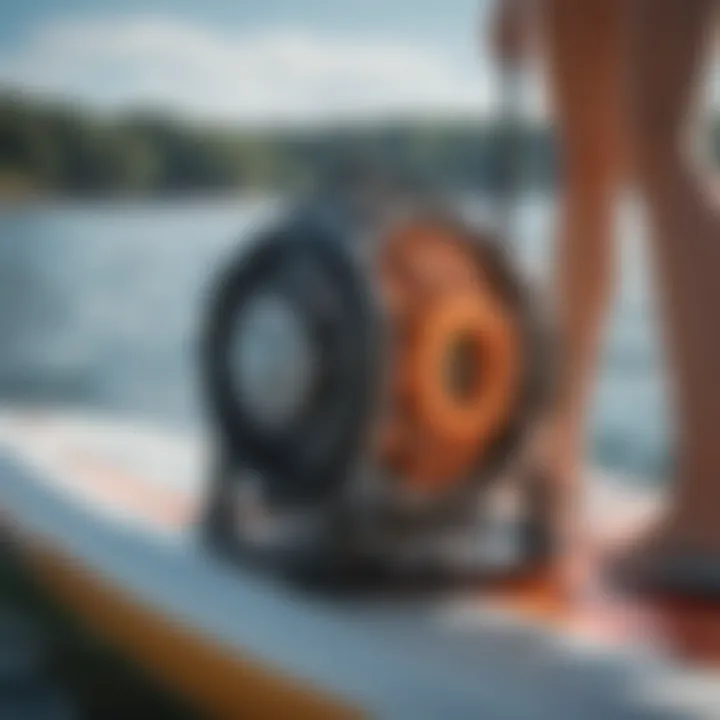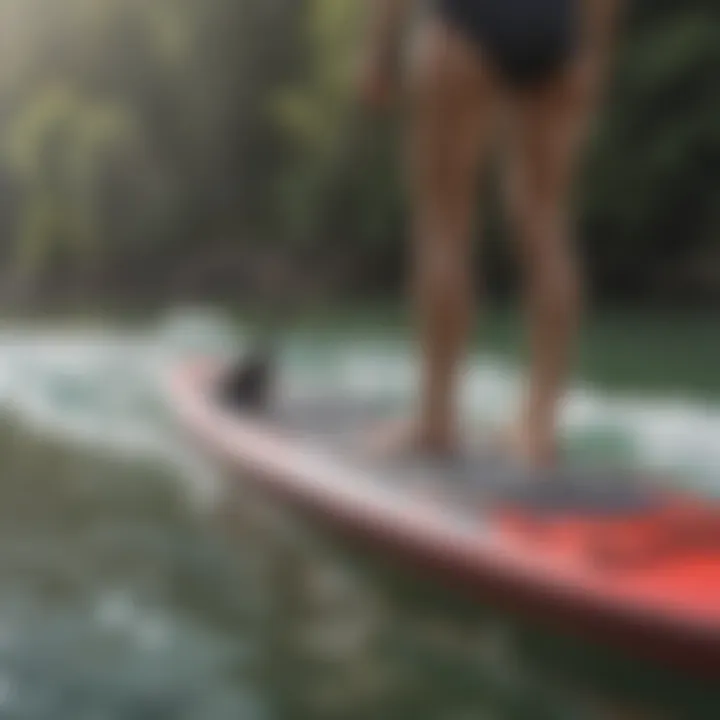Understanding Paddle Board Engines: Innovations Explained


Intro
Paddle boarding has undergone a significant transformation in recent years. With the advent of paddle board engines, the sport is no longer just about gliding across serene waters with the sheer force of one's arms. Innovations in technology have ushered in a new era of paddle boarding, changing how enthusiasts engage with the sport. This article aims to elucidate these changes, focusing on the design and functionality of paddle board engines while exploring their implications within the context of watersports.
From beginner paddlers to seasoned experts, understanding what paddle board engines bring to the table is vital. This guide discusses essential techniques, must-have gear, and the innovations shaping the future of paddle boarding. Moreover, it serves to bridge the gap between traditional paddle boarding and the rising popularity of powered options, ensuring that both enthusiasts and professionals stay well-informed.
The conversation surrounding paddle board engines also touches on various topics, such as the sustainable future of water sports, user experiences, and the evolution of engineering principles that drive this fascinating development.
"Innovation is crucial. It allows us to push boundaries and redefine not only what is possible but also what is enjoyable in watersports."
This piece will not just skim the surface; it will provide an in-depth analysis of paddle board engines, examining their advantages, challenges, and the landscape they are creating for the sport. Prepare to discover how these remarkable engines are reshaping paddle boarding and what it means for the waterways and enthusiasts alike.
Prelude to Paddle Board Engines
The rise of paddle board engines represents a shift in the watersports landscape, marrying tradition with innovation. As paddle boarding gains popularity, the integration of propulsion systems has caught the attention of both seasoned enthusiasts and beginners alike. Understanding paddle board engines isn't just about technology; it's about redefining the way we interact with water and the experiences we can have on it.
The advent of paddle board engines introduces significant advantages. Enhanced speed allows users to cover longer distances with less effort, opening the sport up to a broader audience. Those who may have once shied away from the physical demands of paddle boarding can now find joy in a more accessible experience. Additionally, these engines create new opportunities for exploration, enabling users to navigate remote locations or challenging waters that would have otherwise been out of reach.
However, this innovation does not come without its considerations. With these advances emerge questions about regulation, environmental impact, and the very essence of paddle boarding. Are we still engaging with the spirit of the sport in the same way, or are we drifting towards a mechanical approach that might alter traditional practices? The major points discussed in this article will navigate through the multifaceted landscape of paddle board engines, highlighting key benefits, challenges, and real-world implications.
Definition and Overview
Paddle board engines are essentially propulsion systems either built into or attached to traditional paddle boards. These engines enable the board to move through water with less physical exertion from the user. At their core, paddle board engines can vary widely in design, functionality, and power source. Some systems are electric, employing batteries that allow for hours of usage, while others may harness solar power or hybrid models combining various technologies.
Key Characteristics of Paddle Board Engines:
- Design Variation: From sleek and compact engines that sit atop the board, to fully integrated units, the design choices vary widely.
- Power Source: Electric, solar, or hybrid systems cater to different preferences and environmental considerations.
- User Interface: Most engines come equipped with user-friendly control systems, making operation intuitive even for novices.
"The introduction of engines to paddle boards opens up a new world of exploration, making it accessible for everyone from casual users to serious adventurers."
History and Evolution
The development of paddle board engines can be traced back to the early 21st century, when innovators began to experiment with adding power to traditional boards. At first, these attempts were rudimentary, focusing on basic propulsion methods that often lacked efficiency and usability. Early designs mostly centered around bulky mechanics that riders found cumbersome.
As technology advanced, so did the paddling engines. Lightweight materials began to play a crucial role in design, allowing for a more aerodynamic profile and ease of transport. The introduction of electric propulsion marked a turning point, as it combined performance with user-friendliness, allowing an entire spectrum of paddlers to engage with the water in new ways.
The market for paddle board engines has grown exponentially. Companies are now creating specialized products tailored for different demographics: from leisure paddlers looking for ease to spirited adventurers seeking speed. As this market continues to expand, manufacturers are investing in research and development, paving the way for future innovations that promise to enhance the paddle boarding experience even further.
The Mechanics of Paddle Board Engines
Understanding the mechanics of paddle board engines is crucial because it provides deeper insights into their operation and performance. These engines are designed to enhance the paddling experience, integrating technology with traditional watersport practices. As paddle boarding evolves, so does the need for innovative mechanics that address the various demands of users ranging from casual paddlers to seasoned veterans.
Core Components
The core components of paddle board engines play a significant role in defining their efficiency, efficacy, and overall user experience. It’s important to dive into the specifics of each component to appreciate how they contribute to the successful functioning of the paddle board engine.
Motor Types
Motor types in paddle board engines are fundamentally distinguished by their design and performance characteristics. Generally, two major types dominate the market: brushless DC motors and brushed motors.
- Brushless DC motors are the frontrunners in terms of energy efficiency and longevity. These motors operate without wearing brushes, which minimizes maintenance and increases lifespan. Their ability to deliver consistent RPM over longer periods makes them a beneficial choice for users who value performance in extended sessions on water.
- Brushed motors, while typically less expensive and simpler to manufacture, tend to require more upkeep. They wear out more quickly due to friction from brushes making contact with the motor’s commutator. This leads to reliability issues in the long run.
"Choosing the right motor type can make or break the paddle boarding experience, influencing speed, handling, and reliability on the water."
Control Systems
Control systems in paddle board engines dictate how the engine's power is utilized and directed. The most common control system is the electronic speed control (ESC), which regulates the motor's operation based on user input.
This allows for:


- Precision handling: Riders can easily maintain a desired speed or direction without worrying about overexertion.
- User-friendly interfaces: Most systems include remotes or even mobile app connectivity for seamless adjustments, making it a popular choice among tech-savvy users.
Moreover, advanced control systems can adapt to ride conditions, automatically adjusting power delivery to ensure smooth operation even in choppy waters. While these systems can add complexity and potential points of failure, their benefits often outweigh the drawbacks.
Power Sources
Power sources for paddle board engines primarily revolve around battery technologies. Lithium-ion batteries are the most prominent choice due to their lightweight and high energy density.
Some advantages of lithium-ion batteries include:
- Longer usage times: These batteries can sustain power for longer periods, allowing for extended paddling without frequent recharges.
- Rapid charging capabilities: Unlike other types of batteries, lithium-ion options can achieve full charges in shorter durations, benefitting users who are always on the go.
However, they can also present challenges such as higher costs and a need for careful management to ensure longevity. Users must be mindful of environmental factors that can affect battery life, particularly extreme temperatures.
How Paddle Board Engines Function
The functionality of paddle board engines centers around their mechanisms for propulsion and their ability to seamlessly integrate with traditional paddling techniques. Understanding these functions is vital for those looking to enhance their experience in challenging water conditions.
Water Propulsion Mechanics
Water propulsion mechanics refer to the method through which the engine generates thrust to move the paddle board forward. This is typically achieved through a submerged propeller or jet drive mechanism.
- Submerged propellers are often praised for their efficiency in converting input power into thrust, allowing for agile maneuvers. They create a steady stream of water behind the board, ensuring speed is maintained with minimal resistance.
- Jet drives, on the other hand, work by drawing water in and ejecting it forcefully at the back, providing a powerful thrust while minimizing the risk of damage from debris, which is an appealing factor for many users, particularly in lakes or less maintained waters.
Integration with Traditional Paddling
Integration with traditional paddling is what differentiates paddle board engines from purely motorized vessels. This hybrid approach allows users to engage physically while leveraging the benefits of mechanical assistance.
The unique feature of this integration includes the ability to alternate between engine use and manual paddling. This aspect is advantageous because:
- Flexibility in usage: Riders can switch between paddling for exercise and engaging the engine for a more relaxed experience.
- Skill development: Newer paddlers can build their skills without feeling overwhelmed, as they can always rely on the engine for additional support.
By understanding the mechanics of paddle board engines, users can better appreciate the blend of technology and tradition that defines this innovative segment of the watersports landscape. As developments continue to emerge, the way these engines function will naturally evolve, promising even more exciting possibilities for paddlers worldwide.
Advantages of Using Paddle Board Engines
The introduction of paddle board engines has brought a sea change in the world of watersports, making this activity more appealing and accessible. Paddle board engines provide benefits that extend beyond merely enhancing the thrill of paddling. They address issues of speed, ease of use, and inclusiveness, making them a valuable addition to any watersport enthusiast’s toolkit. Understanding these advantages clarifies why paddle board engines are reshaping the paddle boarding landscape.
Enhanced Speed and Performance
Speed is often a significant factor for both recreational paddlers and serious competitors. Traditional paddling requires considerable physical effort and stamina, limiting how far and fast one can go. Paddle board engines bridge this gap effectively. With the push of a button, paddlers can attain impressive speeds, allowing them to cover longer distances in a fraction of the time.
Engines can come in various forms, each with its own specs. For instance, electrical motors provide swift propulsion without interrupting the serenity of the water, while gas-powered options may offer higher speeds for thrill-seekers.
This increase in speed transforms how individuals approach paddle boarding. Whether it’s exploring distant shores or racing against time, engines can amplify the overall experience. Think of it as unleashing a tidal wave of freedom for adventurers, where the emphasis shifts from merely paddling to enjoying the journey.
Reduced Physical Strain
One of the most commendable benefits of paddle board engines is the relief they offer from physical strain. For many, paddle boarding can feel like an Olympics-level workout, demanding strength and endurance as you navigate waves. Engines mitigate this burden, offering support for those who may not have the physical ability or stamina to paddle for extended periods.
As paddlers leverage the engine's provided thrust, they can conserve their energy for enjoying nature or even engaging in leisurely conversations with companions.
"With the engine, I feel like I can paddle longer without wiping out. It’s relaxing knowing I can kick back if I need to." - A paddleboarding enthusiast
This ease attracts novices and seasoned paddlers alike, enabling families or friends to embark on outings together, regardless of their fitness levels. Reduced strain opens the door for diverse groups to participate, making paddle boarding a more inclusive sport.
Accessibility for All Skill Levels
Accessibility is another feather in the cap of paddle board engines. By leveling the playing field, these innovations allow people of various skill levels to participate in paddleboarding activities. Whether you’re a seasoned expert or a first-time adventurer, engines allow you to enjoy the ride.


This inclusivity can convert hesitant individuals who may feel intimidated by the concept of paddleboarding. With an engine, there’s less pressure to master the perfect stroke or maintain stamina through an entire excursion. Rather, users can focus on enjoying the water, taking in the views, or spending quality time with friends and family.
In summary, there’s a crucial shift at play with paddle board engines: they don’t just change how we paddle; they redefine who can paddle. Where once the sport might have felt exclusive or physically demanding, engines usher in an era of democratized exploration on water, where everyone is invited to join the fun.
Challenges and Limitations
In the world of paddle board engines, while the allure of effortless gliding and enhanced performance draws in many, one must not overlook the challenges and limitations that accompany this innovative technology. Addressing these aspects is vital for both potential users and industry stakeholders to grasp the complete picture. Without shining a light on the obstacles and potential pitfalls, we risk diving headfirst into adoption without a clear understanding of what lies ahead. This section meticulously examines several critical factors that can affect the usability, sustainability, and overall experience of paddle boarding with an engine.
Weight and Portability Issues
One of the paramount concerns with paddle board engines is the weight they introduce. Most paddle boarding enthusiasts cherish the convenience of portability. The cherished ease of tossing a board atop a car or strapping it to a bike rack becomes significantly complicated once an engine is added. High-end engines, while offering more power, often come with considerable weight.
- Balance and Stability: The engine's weight can significantly alter the board's balance. A heavier board may lead to instability, particularly for less experienced paddlers.
- Transportation Challenges: Transporting a heavier paddle board can mean adjusting your entire setup. This is not just an inconvenience; it can deter potential users who favor spontaneous outdoor excursions.
Additionally, as more users gravitate towards electric motors, the combination of weight from both the motor and battery can get cumbersome. For new paddle boarders, the ease of maneuverability that drew them to the sport might feel threatened by cumbersome gear.
Battery Life and Maintenance Concerns
Battery life is another integral aspect when incorporating engines into paddle board usage. Imagine being out on a cute lake or the open sea, only for your board to succumb to unexpected battery depletion. Such scenarios underscore the importance of battery management. The implications here stretch beyond mere inconvenience:
- Range Anxiety: Just as with electric cars, paddle boarders may experience range anxiety, needing to plan out journeys carefully to ensure they don’t run out of power mid-ride.
- Maintenance Overheads: Regular maintenance is essential for battery longevity. Factors such as temperature and usage frequency directly influence how well a battery serves over time.
When engine technology improves, users may find enhanced battery options; however, as of now, understanding the intricacies of battery care remains fundamental for all users.
Environmental Impact
The question of environmental impact is intricate, as paddle board engines transition from traditional paddling to mechanized propulsion. One might argue that the integration of engines can lead to increased ease and accessibility, but this often comes at a cost to nature. Several key considerations come to the forefront:
- Gasoline Engines: For those using internal combustion engines, the effects can range from water pollution to noise disturbance disrupting marine life. The use of fossil fuels can contradict the very ethos of enjoying nature in its pure form.
- Electric Engines: While electric engines promise cleaner operations, the source of the battery's power packs its own baggage. If the energy comes from non-renewable sources, the gains can feel marginal.
With the water ecosystems facing increasing pressure, potential impacts of paddle board engines deserve serious contemplation. Users must weigh convenience against their responsibility to protect the environment.
"With great power comes great responsibility." - This age-old saying is particularly relevant in the discussion of paddle board engines. The advancements in technology should ideally align with sustainable practices to ensure a balanced coexistence with nature.
Navigating the intricacies of these challenges allows for a fuller appreciation of paddle board engines. By staying informed about limitations, users become empowered to make better decisions suited to their individual or communal paddling experience.
User Experiences and Feedback
Gaining insights from user experiences and feedback is vital in the context of paddle board engines. These real-world accounts shed light on the practicality and user-friendliness of these systems, which can often differ from technical specs. Understanding how various individuals—from casual paddlers to seasoned instructors—interact with these innovations can inform manufacturers, help improve designs, and bring valuable insights into the market. User feedback integrates lessons from the field, influencing everything from product longevity to customer satisfaction.
Case Studies of Paddle Board Engine Users
Consider the experience of Sarah, an outdoor adventure guide in Florida. She decided to incorporate paddle board engines into her day trips due to increasing requests for accessible paddling experiences. Sarah found that these engines allowed her clients, many of whom lacked physical paddling strength, to enjoy the tranquil waters of the Everglades without feeling exhausted. Her story highlights how paddle board engines have opened doors for people who may have felt left out of paddle boarding altogether. She reported improved client satisfaction, where participants remarked on the ease with which they navigated through complex waterways.
Similarly, there's Tom, an avid paddler and recent retiree who wanted to extend his adventures. For him, the choice of a paddle board engine transformed his long-distance journeys. He recalls a specific trip along the coast of California, where the engine provided just the needed assistance during some very windy days. Tom's experience underscores the potential of these engines to enhance adventure and exploration without the excessive physical toll.
"The sheer joy of paddling without feeling winded is something I’ve missed. With this engine, I can focus more on the beauty around me," says Tom.
These case studies reflect a broader trend. Users frequently express that the addition of an engine allows them to explore further and stay out longer on the water. This shift creates more fully realized experiences. Key patterns emerge from these narratives, such as users appreciating not just the performance, but the accessibility these engines provide.
Expert Opinions and Reviews
Hearing from experts can further enrich the conversation around paddle board engines. Enthusiasts often turn to short reviews from sports professionals or influencers who test these products. Like many evolving markets, paddle board engines attract attention from a range of professionals who evaluate their performance and usability.
Ashley Grant, a watersport instructor and writer, comments on paddle board engine advancements in her reviews. She emphasizes ease of use combined with safety features, stating that "today’s engines are lighter, more responsive, and include fail-safes like automatic shut-off in emergency situations." Her observations resonate with users who are often concerned about safety. The growing number of safety features has also been well received. Users like Sarah and Tom mention feeling confident allowing their clients to navigate waters with engines, knowing there are measures in place if something goes awry.
In reviews on platforms such as Reddit and Facebook, users share diverse opinions on engine brands and models. As these engines become more popular, the discussions intensify. Knowledge shared among users can provide practical insights that manufacturers and prospective buyers can rely on.
Overall, both user experiences and expert opinions offer substantive feedback for paddle board engines. Collectively, these perspectives provide a comprehensive understanding of how these innovations impact real users in varying environments. The blend of personal accounts and professional assessments contributes richly to the wider discourse on paddle board technology.


Future Innovations in Paddle Board Engines
Future innovations in paddle board engines serve as a pivotal point in redefining the watersport adventure experience. As technology marches forward at a breakneck pace, the implications of incorporating cutting-edge designs into paddle boards are monumental. For enthusiasts and professionals alike, keeping an eye on these innovations not only enriches their understanding but also enhances how they interact with this evolving sport.
Discussions centered around these advancements lay bare the potential benefits such as improved environmental sustainability, increased accessibility, and performance that appeals to both novices and seasoned paddlers. Moreover, examining what’s on the horizon equips users with foresight about the direction the industry is headed, allowing them to make informed choices.
Emerging Technologies
Solar-Powered Solutions
The introduction of solar-powered solutions marks a game-changer in paddle board technology. The essence of these innovations lies in their ability to harness the sun’s energy, translating sunlight into kinetic propulsion. Key characteristics of solar-powered boards include lightweight solar panels integrated into the deck, designed to work remarkably well in various weather conditions. This can seem like a beneficial option, especially for those seeking a green alternative to traditional fuel methods.
One unique feature of these solutions is their self-sustaining nature. Gaining power while on the water means less dependency on heavy battery packs. However, there are disadvantages to consider. The efficiency of solar-powered engines highly depends on weather conditions; cloudy days and short daylight hours can hinder performance.
Hybrid Models
Hybrid models represent another promising avenue in paddle board engine development. These systems combine traditional paddling with electric propulsion, offering a seamless integration of effort and ease. The key trait here is versatility; users can choose when to paddle manually or let the engine do the heavy lifting. This is particularly appealing for those looking to extend their time on the water without exhausting themselves.
The unique feature of hybrid boards is their dual-power setup, allowing for a tailored experience based on user preference or physical condition. While the benefits are clear, including enhanced range and reduced fatigue, potential downsides encompass added weight from the two systems and possibly increased maintenance needs. Balancing these factors becomes paramount for prospective buyers.
Anticipated Market Trends
As we look towards the future, several market trends are starting to emerge, shaping the paddle board landscape. Increased demand for eco-friendly systems is likely to drive the growth of sustainable technologies, pushing manufacturers to innovate further. Meanwhile, the integration of smart technology into paddle boards is gaining traction; features such as GPS tracking, fitness monitoring, and connectivity options are being preferred by tech-savvy adventure seekers. Furthermore, those who are enthusiasts may witness a significant uptick in rental services focusing on electric paddle boards, allowing for broader access without the upfront investment.
In summary, the innovations in paddle board engines reflect a blend of practicality and excitement. They promise to not only make paddle boarding more efficient but also ensure the sport remains enjoyable and aligned with modern environmental standards.
Regulatory and Safety Considerations
When it comes to paddle board engines, understanding the regulatory landscape and safety protocols is just as critical as analyzing technological advancements. As more enthusiasts and professionals integrate these engines into their watersport activities, it's essential to navigate the legal frameworks that govern their use, ensuring not only compliance but also the safety of everyone involved.
Navigating Legal Frameworks
The world of paddle boarding is not without its set of regulations. Various jurisdictions have different laws regarding watercraft, and paddle board engines fall under those rules. Before hitting the water, users must be aware of local regulations that impact everything from engine specifications to licensing requirements.
- Operational Limits: Many areas place restrictions on motorized watercraft, defining where such vessels can operate. Depending on local laws, paddle boards with engines might face limitations at certain beaches or waterways.
- Licensing and Permits: Some places may require a special permit for using motors on paddle boards. It’s crucial to check if you need a license to operate your paddle board engine in your chosen location.
- Insurance Considerations: As boaters know well, insurance can be a lifesaver. Some paddle board users might consider getting liability coverage particularly if they are frequenting crowded waterways where mishaps are more likely to occur.
"Understanding the legal requirements is paramount; ignorance is not a defense when operating in regulated areas."
Safety Protocols for Engine Use
Safety should always be a priority for paddle board engine users. Setting the right protocols can mean the difference between a fun-filled day on the water and an unfortunate accident. Here are key safety measures:
- Personal Flotation Devices (PFDs): Wearing a properly fitted life jacket while using a paddle board with an engine is not just smart; in many places, it’s the law. This simple measure significantly increases safety during unexpected situations.
- Pre-Flight Checks: Just like any mechanical device, paddle board engines require regular inspection and maintenance. Before heading out, make sure to check vital components such as the fuel level, battery condition, and overall engine integrity.
- Emergency Procedures: Familiarize yourself with emergency procedures specific to your gear and local waters. Whether it’s an engine failure or a sudden change in weather, knowing how to respond can save lives.
- Educate Others: If you're paddling in a group, ensure everyone understands the safety protocols too. Just because someone is an experienced paddler doesn't mean they are aware of the added complexities that an engine brings.
Investing a little time in understanding the regulations and safety protocols can lead to a safer, more enjoyable experience for everyone on the water. Whether you’re new to paddle boarding or a seasoned pro, continual awareness of these factors enhances not only personal safety but the overall health of the paddling community.
Epilogue: The Future of Paddle Board Engines
The future of paddle board engines is not just a question of innovation but also a matter of practicality and adaptability in the ever-changing domain of watersports. As we plunge deeper into the technological advancements, the way we perceive and experience paddle boarding is evolving rapidly. Embracing engine technology can enable a wider audience to enjoy this sport, providing opportunities for both leisure exploration and rigorous training.
Summary of Key Insights
In examining paddle board engines, several significant points have emerged:
- Diversification in Design: Current trends show a move towards designs that allow for both powered and manual paddling, catering to diverse user preferences.
- Sustainability Measures: Growing focus on environmental conservation is steering development towards more eco-friendly propulsion methods, like solar-powered engines, which align with broader sustainability goals.
- Enhanced Accessibility: With engines reducing physical constraints, individuals of varying skill levels and those with mobility challenges can participate more actively in the sport.
Collectively, these insights highlight an essential shift towards integrating modern technologies that respect both the sport’s traditions and its future viability.
Final Thoughts on Watersport Integration
The integration of paddle board engines into the watersport ecosystem poses both opportunities and responsibilities. It encourages a blend of traditional paddle techniques with motors, enhancing versatility without overshadowing the essence of the sport.
"The challenge is striking harmony between innovation and authenticity. As paddle boards evolve, so must our understanding of what it means to paddle."
As this evolution unfolds, it is vital for stakeholders—from manufacturers to everyday paddlers—to engage in dialogues about safety, regulations, and ecological considerations. The ongoing conversations about safety protocols and navigating legal frameworks will shape how we adopt this innovative technology, ensuring paddle boarding remains not only enjoyable but also safe and sustainable for future generations.
In light of all these emerging trends, paddle board engines are likely to play a pivotal role in transforming how we interact with water, championing a future that is as adventurous as it is responsible.







